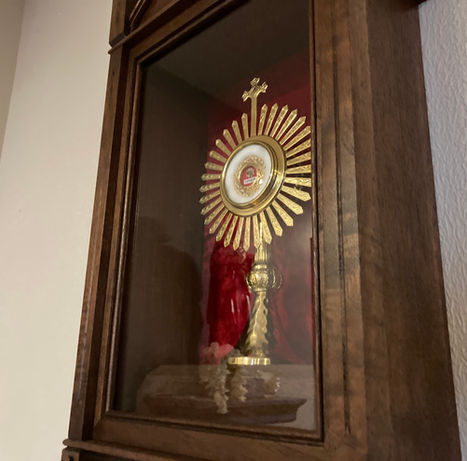
Our Church
St. George Catholic Church was established in the City of Republic in 2016 but has been serving Catholics in Greene and Christian counties of Southwest Missouri since 2010. We are a Catholic Church within the Personal Ordinariate of the Chair of St. Peter, a jurisdiction created by Pope Benedict XVI in 2012 for Catholics with an attachment to the Medieval English Patrimony, sometimes called the "Anglican Patrimony." We are not an Anglican Church. We are a Catholic Church, in full unity with the Holy See of Rome, and working in cooperation with the local Diocese of Springfield - Cape Girardeau. Any Roman Catholic may visit or become a member of our church. Our bishop's name is Stephen J. Lopes. His cathedral is Our Lady of Walsingham in Houston, Texas, and he is a member of the U.S. Conference of Catholic Bishops (USCCB) .
The English Patrimony can be summarized as the traditions, liturgy and spirituality that comes to us from Medieval England, much of which was preserved within Anglicanism over the last five centuries. Rome has re-adopted this Patrimony back into the Catholic Church, as part of welcoming Anglicans and Methodists who return to Catholicism, and as a gift to all Catholics in the whole Church.
All members of St. George are Roman Catholics, who adhere to the teachings of the Catholic Church and the Code of Canon Law. Any Catholic may attend St. George and meet the Sunday obligation here. Those familiar with the Medieval English Patrimony will immediately recognize the familiar sights and sounds of the Book of Common Prayer as expressed through our liturgy approved by Rome - Divine Worship. You can learn more about the liturgy of the Medieval English Patrimony by clicking here. You can learn more about the history and spirituality of the English Patrimony by clicking here. Membership at St. George is open to anyone who wishes to live faithfully as a Catholic, in full unity with the Pope and the Holy See of Rome.
Our History
Christianity originally came to the British Isles in about the 4th century (early 300's AD) in the days of the ancient Roman Empire. This early Christian faith was likely brought to the islands by Celtic missionaries from the mainland continent, as well as Roman legions and their company of slaves. After the fall of the Roman Empire, these early British Christians were attacked and driven to the west side of the island (Wales) by Pagan Germanic tribes: Angles, Saxons and Jutes. This caused them to be cut off from the mainland Catholic Church on the continent for some time. In AD 595, Pope Gregory the Great dispatched from Rome a Benedictine prior by the name of Augustine, together with 40 monks, to evangelize the Anglo-Saxon Pagans of eastern Britain (England) by convincing King Ethelberht, and his Kingdom of Kent, to turn away from Anglo-Saxon Paganism (a variant of Heathenism based on the Germanic and Nordic gods). It is likely that Pope Gregory chose King Ethelberht as his missionary target because he had recently married a Christian princess from Paris. After a couple years, Augustine's mission was a success, and King Ethelberht was baptized the first Christian king of the Anglo-Saxons on Christmas Day in AD 597. The king then gave Augustine land, in his own royal city of Canterbury, to build a monastery and convert as many of his subjects as possible. Augustine was then consecrated the first Archbishop of Canterbury by Pope Gregory, and was later canonized a Saint. Today he is known as Saint Augustine of Canterbury. (He should not be confused with the previous bishop in Northern Africa by the same name -- Saint Augustine of Hippo.) When Anglo-Saxon missionaries from Canterbury encountered the previously isolated Celtic-Irish missionaries in various parts of Britain, there were some differences in discipline and practice. These were resolved at the Synod of Whitby in AD 664. From that time forward, all missionaries in the British Isles worked together in unison under Roman Catholic direction.
Known as Mary's Dowry, England then became one of the most Catholic countries in all of Europe. During the Middle Ages, England played a central role in converting northern Europe to Christianity, not limited to, but including large portions of Germany and the Norse people of Scandinavia -- the Vikings. England became the home of numerous monasteries as well, which served as a headquarters for evangelistic efforts.
England became home to one of Europe's early Marian apparitions. In AD 1061 the Virgin Mary appeared to an English noblewoman named Richeldis de Faverches in the village of Walsingham in Norfolk. Lady Richeldis built a structure named The Holy House in Walsingham which later became a shrine and place of pilgrimage to this very day.
England would have seemed the least likely, of all countries, to participate in the 16th-century Protestant Reformation. Of all the Protestant denominations that arose from the Reformation period, English Catholics were initially forced by King Henry VIII to leave Rome against their will, all over an annulment the pope refused to grant for the king's marriage with Catherine of Aragon. After a period of contention for the royal crown by Henry's offspring, which resulted in multiple religious conflicts, England eventually came down on the Protestant side of the Reformation under Queen Elizabeth I. According to the Oxford Dictionary of the Christian Church by F. L. Cross (page 65) the religion of the Church of England eventually came to be known as Anglican by the 19th-century, based on the Latin word for "the English" -- Anglica.
As the British Empire spread across the world, Anglicanism spread with it, setting up churches in every corner of the globe. In the United States, Anglicanism was historically known as The Episcopal Church USA, and together with all the Anglican churches around the world, these form the Anglican Communion. Many Protestant denominations in North America originally come from, or are offshoots from, Anglicanism. These include, but are not limited to: the Baptist churches, Pentecostalism (such as the Assemblies of God for example), Methodism, Churches of Christ, Churches of God, Quakers, the Church of the Nazarene, Foursquare churches, Calvary Chapel, Vineyard Fellowship, and so on. They all have a common origin that can easily be traced back to the Church of England and the English Reformation. So it can be said, that each and every one of them can rediscover their historic spiritual roots within the English Patrimony.
About two-hundred years ago, a group of Episcopalians (American Anglicans) in the United States began what was initially called the "high church movement," wherein an attempt was made to recover many of the Catholic traditions that were lost during the Reformation period. A similar movement began in England in what later came to be known as the "Oxford Movement." From England this group of nineteenth-century Anglican scholars sought to recover as much English Catholicism as could be restored and then seek corporate reunion with Rome at some future date. Ecumenical relations between Rome and Canterbury continue to the present time having made much progress, and also suffering many setbacks along the way.
During the late 1970s, a small group of Anglican (Episcopal) priests in the United States petitioned Rome for immediate conversion since they had already accepted the full teachings of the Catholic Church. They sought some mechanism through which they could enter the Catholic Church, and become Roman Catholics, but retain their English Patrimony which included their liturgy, customs and pastoral heritage. The petition was granted by Pope Saint John Paul II in 1980, and in that same year the "Anglican Use Pastoral Provision" was created. This allowed Anglican priests to come into the Catholic Church and retain some of their traditional English customs. It even allowed these men to be ordained as Catholic priests, despite the fact that some were married and had children. After decades of persistent requests by Anglican priests, bishops and laity; Pope Benedict XVI, in 2009, expanded this Pastoral Provision to a much larger scale. The document is called Anglicanorum Coetibus, meaning "Groups of Anglicans," and it is an Apostolic Constitution that governs these Catholic communities in a structure called an "Ordinariate." Like the military ordinariates, this structure serves as a super-diocese, overlapping regular territorial dioceses, pertaining only to specific parishes and persons who are members. They are governed by an Ordinary, who can be either a bishop of a priest with all the powers of a mitred abbot.
On January 15, 2011, Pope Benedict XVI created the first personal ordinariate to cover England, Wales and Scotland (the whole U.K.) and named it the Personal Ordinariate of Our Lady of Walsingham. On January 1, 2012, he created the second personal ordinariate to cover the United States and Canada, naming it the Personal Ordinariate of the Chair of St. Peter. It is to this ordinariate that Saint George Catholic Church belongs. On June 15, 2012, His Holiness created a third personal ordinariate to cover Australia and all of Oceania as far north as Japan, naming it the Personal Ordinariate of Our Lady of the Southern Cross.
Our particular community was initiated in 2010 by Mr. Shane Schaetzel, an Evangelical convert to the Catholic Church through Anglicanism, with the approval and blessing of Bishop James V. Johnston Jr., Bishop of the Diocese of Springfield - Cape Girardeau at that time. Evening Prayer (according to Divine Worship) began in Springfield that year with the assistance of Mr. Kevin Combs, a lifelong Roman Catholic, and Mr. Gregory Epps, a lifelong Anglican. In 2014 our community was formerly incorporated into the Personal Ordinariate of the Chair of Saint Peter. That same year we began quarterly celebration of Mass according to Divine Worship under the direction of Fr. Kenneth Bolin, an Ordinariate priest. In June of 2015 our community was formally named Saint George. In May of 2016 we were established as a regular Catholic Church in Republic, Missouri, just outside of Springfield, and Fr. Chori Seraiah was named as our first Parochial Administrator. From 2016 to 2019 we gathered for worship at the old Franciscan Retreat Center off Assisi Way near Miller Park in Republic. After we outgrew this place, our community moved into our own building at 1404 East Hines Street in Republic.
Our Liturgy
Divine Worship is a third form of the Roman Rite, that was reintroduced to the Catholic Church in 1984 after nearly five centuries in Protestant exile. During this period, many elements of Divine Worship were preserved in the Anglican Book of Common Prayer. When some Anglicans began converting back to the Catholic Church in the 1970s and 80s, they requested to bring the Catholic elements of their liturgy and patrimony with them. Pope St. John Paul II agreed and with that Divine Worship was restored as a fully Catholic liturgy. It was an ecumenical triumph!
After the creation of the first Ordinariates between 2011 to 2012 by Pope Benedict XVI, Divine Worship underwent some revisions which more closely associated it with pre-reformation English (Sarum) Catholic liturgy. All of this was done with the assistance and oversight of Rome. This Medieval English Patrimony is generally high church, which means it has many traditional characteristics. Our liturgy is celebrated with the priest facing ad orientem (liturgical east) and communion is always served on the tongue while kneeling. Overall, the liturgy is close enough to a regular Catholic Mass that any regular Catholic should have no problem easily adapting to it. An FAQ on Divine Worship can be seen here. More information on the ecclesial context and history of Divine Worship can be read at Bishop Lopes' Hillenbrand_Lecture. A video of a full Divine Worship Mass, celebrated in Orlando by Bishop Lopes, can also be viewed here...
Our Patron
Do you speak English as your native language? If so, then Saint George means something to you whether you realize it or not. Five-hundred years ago, a tiny little country on an island in the North Atlantic began the most dramatic expansion in the history of the world. English culture, religion, law, language and heritage, were exported first to North America, then Central America, then Africa, Australia and New Zealand. For a time, it became the largest empire in the history of the world. The sun never set on the English Empire, because it controlled a portion of every corner of the globe. The empire fell apart rather quickly, just a hundred years ago, but its legacy remains. The reason why we speak English today is because of its influence.
Long before its imperial expansion, and long before its break with Rome, England was a Catholic country, and its Patron Saint was (and still is) Saint George. The identity of England is so intertwined with Saint George that we could say Saint George is England, and England is Saint George.
Now Saint George was actually a martyr who was born in ancient Palestine, but died in Asia Minor in about AD 303 under the reign of Caesar Diocletian. He was a soldier and commander in the Roman army, but he was also a Christian. So when Caesar Diocletian ordered that all Christians within his army be executed, it turned out that George was among them. Seeing as how George was such a trusted officer, and his father before him was so well respected in the Roman army, Diocletian made every effort to save him from death. He tempted him with riches, land and women, if he would only deny his faith in Christ and conform to emperor worship by throwing a pinch of incense on a Pagan altar and saying aloud "Caesar is Lord." George refused, promising lifelong loyalty to Caesar, but he could only worship Jesus Christ as Lord. Unable to persuade George, Diocletian ordered his execution.
It is said that George was martyred in the most inhumane way imaginable. He was tied to a wheel and rolled over spikes or swords, that slowly pealed away his flesh. It is said he fainted three times from the excruciating pain, and was revived all three times, before he was finally killed. This act of tremendous courage, combined with his resistance of extreme temptation to save his life and be rewarded with riches and pleasure, caused him to be revered as one of the greatest martyrs and saints in antiquity. As a result of his sacrifice, Christians were emboldened in the area, many more converts were made, people resented Caesar's treatment of one of his most honored and loyal soldiers. The result was that Caesar began losing control of the area, and Christianity became more entrenched. Within a decade, Diocletian would be dead, and his successor Caesar Constantine would issue the Edict of Milan, ordering that Christianity be tolerated, and that all persecution of Christians cease. Within a century after that, Christianity would become the official religion of the Roman Empire. Saint George had fallen victim to the last great persecution of Christianity by the Pagan Roman Empire, and his martyrdom played a role in securing the end of all Roman persecutions and the end of Caesar worship in general. Saint George was entombed in the City of Lod, which is currently south of Tel Aviv, in Israel.
Nearly a thousand years later, knights returning from the crusades in Palestine, brought the devotion to Saint George back with them, and he subsequently became the Patron Saint of England. Figurative legend developed around him as a knight who slew a dragon to save a princess from its evil clutches. The imagery was designed to draw attention to the way George's martyrdom robbed power and influence away from the Pagan cult of Caesar worship. The dragon represents the Pagan cult of Caesar worship, which was threatening to kill the Church, represented as the princess in distress. In historical reality George gave his life for Christ, but in doing so, he figuratively killed the dragon, because his act of courage and virtue secured the collapse of the Caesar worship cult in the area. It's a story that every English-speaking Christian should be familiar with. Even if you're not a Christian, it gives insight into the culture of the language you speak. Because you see, the story of Saint George, whether you choose to look at his literal martyrdom or figurative adventure, embodies the type of virtue sought by the English. From a very early age, English children are taught the figurative story of Saint George, and later told its historical meaning once they mature to an appropriate age. It is meant to teach them the virtues of courage and self-sacrifice in the name of all that is true and good.
The cross of Saint George can be found on the flag of England. It is white, for purity, with a red cross representing martyrdom. We are familiar with it as a traditional English flag, which is also overlaid as the center cross on the British flag. The British flag depicts the red cross of Saint George up front with white backing. Behind the cross of Saint George is the cross of Saint Andrew, which is a white X-shaped cross (or saltire) on a blue field. This is the flag and patron Saint of Scotland. The red X-shaped cross (saltire) is for Saint Patrick, who is the patron Saint of Northern Ireland. Often the simple red and white flag of England is depicted in artistic representations of Saint George. Saint George is widely venerated in Catholicism, Orthodoxy and Anglicanism. His feast day is April 23, which commemorates the day of his martyrdom on April 23, 303 AD. He is even known and respected among Muslims in the Middle East, from Egypt to Asia Minor, but particularly in Israel and Palestine. It has been said that the popularity of Saint George could be gauged by simply yelling his name in the middle of a crowded Middle Eastern street to see how many men will turn their heads to see who's calling them. George has also been a popular name for English kings, and even the great general who led American colonists in rebellion against the British Empire was named George Washington. Saint George is also the patron saint of: soldiers, cavalry, scouting, Palestinian Christians, horses, a host of various cities and countries.
The tomb of Saint George is located in Lod, Israel, and is a major site of pilgrimage for those who wish to venerate the relics of this great Christian Saint. It is housed within the Church of Saint George which is an Eastern Orthodox structure shared with an Islamic mosque. The church contains the sarcophagus of St George.
Here, at St. George Catholic Church in Republic, we are blessed to have an actual relic of St. George himself. It is a fragment of bone, taken from his body, which we keep in a special place of veneration within our church building. The relic has been certified by Rome as authentic. Part of St. George is with us daily in the worship and adoration of our Lord and Savior, Jesus Christ.

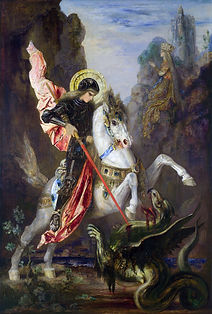


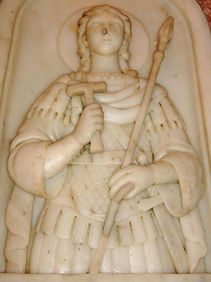
Our Lady
The Blessed Virgin Mary is venerated under the title of Our Lady of Walsingham both among Catholics and Anglicans in England. The title comes from a series of Marian apparitions to Richeldis de Faverches, a pious English noblewoman, in AD 1061, in the village of Walsingham in Norfolk. This was during a time when England was profoundly Catholic and was known throughout Europe as "Mary's Dowry." According to the approved testimony of Lady Richeldis, the Blessed Virgin Mary appeared to her, and carried her soul away in a vision of religious ecstasy. She was taken to 1st-century Nazareth, and shown the home where the Holy Family once lived. This was apparently the same house in which the Annunciation of the Archangel Gabriel occurred. Lady Richeldis was charged with building a replica of this house in the village of Walsingham in Norfolk, England. The replica came to be known as the "Holy House" and became a place of pilgrimage for many devout Catholics in England. A wooden statue of the Blessed Virgin Mary was commissioned which later came to be known as "Our Lady of Walsingham." Devotion to our Lady under this title spread far and wide throughout the British Isles and Northern Europe. The "Holy House" became a place of pilgrimage during medieval times, when due to wars and political upheaval, travel to Rome was dangerous.
In 1340, the Slipper Chapel was built at Houghton St Giles, a mile outside Walsingham. This was the final "station" chapel on the way to Walsingham. It was here that pilgrims would remove their shoes to walk the final "Holy Mile" to the shrine barefoot.
No less than seven English kings made regular pilgrimage to the site: Henry III, Edward I, Edward II, Henry IV, Edward IV, Henry VII and even Henry VIII. Apparently, Queen Catherine of Aragon was also a regular devotee.
After Henry VIII's unlawful divorce of Catherine of Aragon, and his break with the Catholic Church in AD 1534, all English shrines and monasteries were suppressed. The suppression of the Holy House, and the attached priory, came in AD 1538 under the supervision of Sir Roger Townshend, a local landowner. The buildings were looted and destroyed. The wood statue of Our Lady burned. The priory with the churchyard and gardens was granted by the Crown to Thomas Sydney. All that remained of it was the gatehouse, the chancel arch and a few outbuildings. The Elizabethan ballad, "A Lament for Walsingham," expresses something of what the Norfolk people felt at the loss of their shrine of Our Lady of Walsingham.
Catholicism remained illegal in England for hundreds of years, but in the 19th century, laws against the Catholic Church were relaxed. After this, Catholic shrines and monasteries gradually made a comeback. Simultaneously during this century, Anglicans were beginning to rediscover the Catholic roots of their faith (the "high church" and Oxford movement) and reintroduced them to their worship and way of life. Thus, devotion to Our Lady of Walsingham enjoyed duel devotion from both Catholics and Anglicans in subsequent years.
In 1896, Charlotte Pearson Boyd purchased the 14th-century Slipper Chapel and restored it. The new statue of the Mother and Child was carved at Oberammergau and based on the design of the original statue. The "Holy House" had been rebuilt at the Church of the Annunciation, which the Shrine is part of. On February 6, 1897, Pope Leo XIII issued a Papal decree from Rome blessing the Marian image of Our Lady of Walsingham for public veneration, and re-established the restored the 14th-century Slipper Chapel as a Catholic shrine, now the center of the National Shrine of Our Lady of Walsingham. On August 15, 1954, Pope Pius XII granted a canonical coronation to the Catholic image via the Papal Nuncio, Bishop Gerald O'Hara, using a gold crown now venerated in the Slipper Chapel. On May 26, 1982, Saint John Paul II venerated the image for Pentecost at the Wembley Stadium during an outdoor Mass. On December 27, 2015, Pope Francis raised her sanctuary to the status of a minor basilica through an apostolic decree from the Congregation for Divine Worship and the Discipline of the Sacraments. The revival of this medieval devotion in modern times is a great sign of healing following the turmoil of the Protestant Reformation. Today the shrine is shared by both Catholics and Anglicans, who keep this devotion in common.
Following Anglicanorum Coetibus, Pope Benedict XVI created the first Ordinariate for former Anglicans in the U.K., naming it the Personal Ordinariate of Our Lady of Walsingham. He followed with the creation of the Personal Ordinariate of the Chair of Saint Peter in the U.S. which also names Our Lady of Walsingham as its patron. Another Walsingham shrine was dedicated at the U.S. Ordinariate cathedral in Houston, Texas, which incidentally is also named after Our Lady of Walsingham. The Blessed Virgin Mary is venerated under this title throughout the ordinariates worldwide.
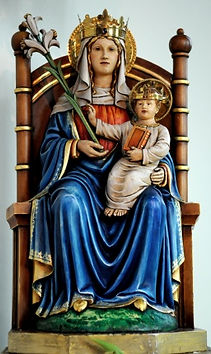

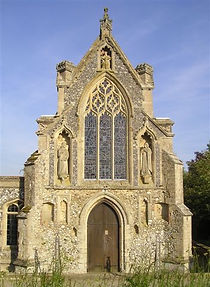

.png)



